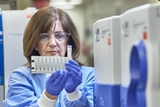What is Beckwith-Wiedemann syndrome/spectrum?
Beckwith-Wiedemann syndrome/spectrum (BWSp) is a genetic condition commonly characterized by overgrowth. The severity of this condition varies widely in children and is usually recognized at birth, when a child is born with features of BWSp. However, few children have all the associated characteristics. Some may have only a single, subtle feature, such as one side of the body being larger than the other (also known as lateralized overgrowth).
BWSp occurs in approximately 1 in 11,000 births, with about equal incidence in boys and girls. However, because children who have milder cases may never receive a diagnosis of BWSp, this figure may be an underestimation.
Signs and symptoms
There is a wide range of physical features associated with Beckwith-Wiedemann syndrome/spectrum. These include:
- Large birth weight and length (macrosomia)
- Overgrowth of one side or one part of the body (lateralized overgrowth or hemihypertrophy/hemihyperplasia)
- An enlarged tongue (macroglossia)
- Low levels of sugar in bloodstream (hypoglycemia) during the newborn period and sometimes prolonged hypoglycemia (due to hyperinsulinism)
- Defects in the abdominal wall (such as umbilical hernia or an omphalocele, where the intestines and sometimes other abdominal organs protrude from the abdominal wall outside the body)
- Enlarged abdominal organs, such as the kidneys, liver and pancreas
- Pits or creases in the earlobe or behind the ear
- An increased risk of developing certain tumors during childhood (most which can be cured with proper treatment)
Causes of Beckwith-Wiedemann syndrome/spectrum
There are several known genetic causes of Beckwith-Wiedemann spectrum, which generally result in changes in the expression of one or more of the genes at a region of chromosome 11 known as 11p15.
In most cases, these genetic changes occur in some but not all of the cells, resulting in mosaicism. Mosaicism means that some parts of the body have cells with normal chromosome 11 and other parts have cells with changes on chromosome 11. This heterogeneity leads to the spectrum of clinical features seen in Beckwith-Wiedemann syndrome.
Normally, people have two copies of chromosome 11, one inherited from their biological mother and one from their biological father. The maternal copy of chromosome 11 will express some genes that control growth on chromosome region 11p15 that the paternal copy does not, and vice versa. This phenomenon is called imprinting, and is caused by methylation, or a process of marking the DNA to turn certain genes on or off. The balance of gene expression from the maternal and the paternal copies are what produce normal, symmetric growth.
However, in patients with Beckwith-Wiedemann syndrome/spectrum, different parts of this process can be changed. Possible causes for Beckwith-Wiedemann syndrome are:
- Methylation changes at chromosome 11p15: Methylation changes could add or delete a mark, which would result in a gene being “turned on” when it should be “turned off,” or “off” when it should be “on.”
- Uniparental disomy (UPD) at chromosome 11p15: UPD occurs when both copies of 11p15 are inherited from only one parent. In cases of UPD in Beckwith-Wiedemann spectrum, both copies of chromosome 11p15 are inherited from the father (paternal UPD). In these cases, the patient expresses only the genes from the father’s chromosome without being counterbalanced by the mother’s.
- Alterations, known as pathogenic variants, of the CDKN1C gene, or rarely the regions where methylation marks are made, can occur.
- Chromosomal abnormalities at 11p15: These changes can include deletions (missing genetic material), duplications (extra genetic material), translocations (genes in the wrong place) and inversions (rearranged genetic material).
While some cases are inherited from a parent, most cases occur as new genetic abnormalities only within the affected child.
Diagnosis and genetic testing
A child can have a clinical diagnosis of Beckwith-Wiedemann spectrum, meaning the diagnosis is made when a child has some or all of the physical features associated with the condition. A clinical diagnosis can often be confirmed by genetic testing, which may determine the molecular subtype of the condition.
Because lateralized overgrowth (hemihypertrophy) can present either as an isolated condition, or as a feature of Beckwith-Wiedemann syndrome, all children with lateralized overgrowth should seek an evaluation from a geneticist to establish a correct diagnosis. Genetic testing also may help to determine whether, and how, these disorders occur within a family, which would provide information about the chance for recurrence in other children. Testing for these disorders requires collecting a blood sample or other tissue samples (usually DNA from blood cells).
A normal genetic test result does not rule out the diagnosis of these disorders. Because BWSp is a mosaic condition (meaning only some of the cells in the body are affected), it is possible that the genetic change leading to Beckwith-Wiedemann syndrome was not present in the tissue tested. It is sometimes recommend that additional tissue be collected from patients with suspected Beckwith-Wiedemann spectrum, in conjunction with other surgical procedures when possible, so further testing can be done.
Experts at CHOP recommend that children who have features consistent with a clinical diagnosis of Beckwith-Wiedemann syndrome or isolated lateralized overgrowth — but who receive negative genetic test results — receive the same medical management and cancer surveillance protocol as children who have a confirmed genetic diagnosis.
Cancer risk
Children with Beckwith-Wiedemann spectrum and isolated lateralized overgrowth are at an increased risk of developing certain cancers during childhood. The risk of developing cancer is estimated to be 5 to 10 percent, but that risk may vary depending on the specific genetic cause of the child’s condition.
- Wilms' tumor, a cancer of the kidney, is the most common cancer found in these children. Ninety five percent of Wilms' tumors occur in Beckwith-Wiedemann syndrome or hemihypertrophy patients by age 7.
- Hepatoblastoma, a cancer of the liver, is the second-most common cancer in patients with Beckwith-Wiedemann syndrome or isolated hemihypertrophy. This cancer usually develops by 30 months of age.
- Rarely, adrenocortical carcinoma, neuroblastoma or rhabdomyosarcoma.
Treatment
Cancer screening and follow-up care
We recommend that patients with Beckwith-Wiedemann spectrum or isolated lateralized overgrowth have regular screenings in order to detect potential cancers as early as possible. Wilms' tumor and hepatoblastoma are cancers that can be cured with proper treatment. The probability of cure depends in part upon the extent of the cancer’s spread (its stage) at diagnosis, as well as its histology or acquired genetic changes in the tumor tissue. Research shows that early detection leads to improved outcomes, as tumors are then smaller and easier to remove surgically. An earlier diagnosis may also reduce the need for chemotherapy and lower the dose of, or eliminate the need for, radiation treatment.
All cancer screening should be performed in consultation with a pediatric geneticist or oncologist, and radiology studies should be reviewed by a radiologist with pediatric expertise. In the event that screening results in a suspected or confirmed tumor, we recommend a prompt referral to a pediatric oncologist.
CHOP recommends the following cancer screening protocol for patients suspected of having, or proven to have, Beckwith-Wiedemann spectrum or isolated lateralized overgrowth:
Abdominal ultrasound
An abdominal ultrasound should be performed every three months until 7 years of age. Until the third birthday, the ultrasound should include views of the liver, kidneys and other internal organs. After the third birthday, renal ultrasounds with views of the adrenal glands should be performed until 7 years of age.
The risk for hepatoblastoma drops significantly in children older than 3, so the remaining ultrasounds can focus specifically on the kidneys (renal ultrasounds), which includes the adrenal glands that sit on top of the kidneys.
Abdominal ultrasounds are safe and painless, and do not involve the use of radiation.
Measurement of blood alpha-fetoprotein (AFP) concentration
A blood test to measure serum AFP should be performed every three months until your child's third birthday. AFP is a protein released by immature or damaged liver cells, and it is released at higher levels by hepatoblastoma tumor cells. This is an extremely sensitive way to detect these cancers.
Because AFP levels are normally high during the newborn period, measurements should be performed regularly and reviewed by an experienced pediatrician, geneticist or pediatric oncologist.
The key with AFP levels is to follow the trend — normal levels are expected to decrease over time. Whenever possible, AFP screening should be done at the same center for consistency of results.
Additional healthcare needs
Some children with Beckwith-Wiedemann spectrum and isolated lateralized overgrowth may need to see other medical specialists. Geneticists can also assist with referrals to these specialists and aid in monitoring tumor screening.
- Oncology: Oncologists can discuss cancer risks, as well as coordinate and review the results of appropriate tests for cancer surveillance.
- Orthopedics: Children with leg-length discrepancies may require evaluation by an orthopedist.
- Plastic surgery: Children with enlarged tongues should be evaluated by a plastic surgeon and have formal evaluations for potential effects on feeding, speech and sleep.
- Endocrinology: Children with severe hypoglycemia should be evaluated by an endocrinologist, and treatment may be required until this normalizes.
Additional evaluations are based on clinical needs.
Outlook
Most children with Beckwith-Wiedemann spectrum grow up to be healthy adults.
The physical features of Beckwith-Wiedemann spectrum often become less noticeable as children grow. They are often larger than their peers during childhood, but their growth slows as they get older. By adolescence, growth tends to normalize and cancer risk decreases. They generally grow up to be adults of above average height.
Adults with these disorders can lead a normal life and have healthy children. They typically have normal intelligence and normal lifespans. Some of the visible, physical signs of Beckwith-Wiedemann spectrum, such as a disparity in leg length or an enlarged tongue, may require surgical correction, but most of the characteristics become less apparent with time.

Our research
We are constantly striving to make research discoveries that lead to better treatment options.
Resources to help
Beckwith-Wiedemann syndrome/spectrum Resources
Beckwith-Wiedemann Syndrome and Overgrowth Genetics Clinic Resources
We have created resources to help you find answers to your questions and feel confident with the care you are providing your child at home.
Reviewed by Jennifer M. Kalish, MD, PhD, Evan Hathaway, MS, LCGC
Reviewed on 06/10/2025


